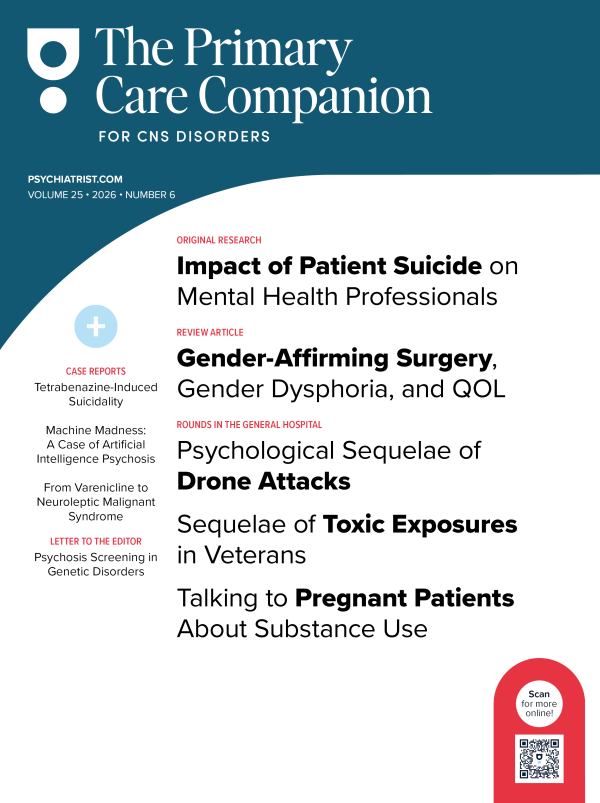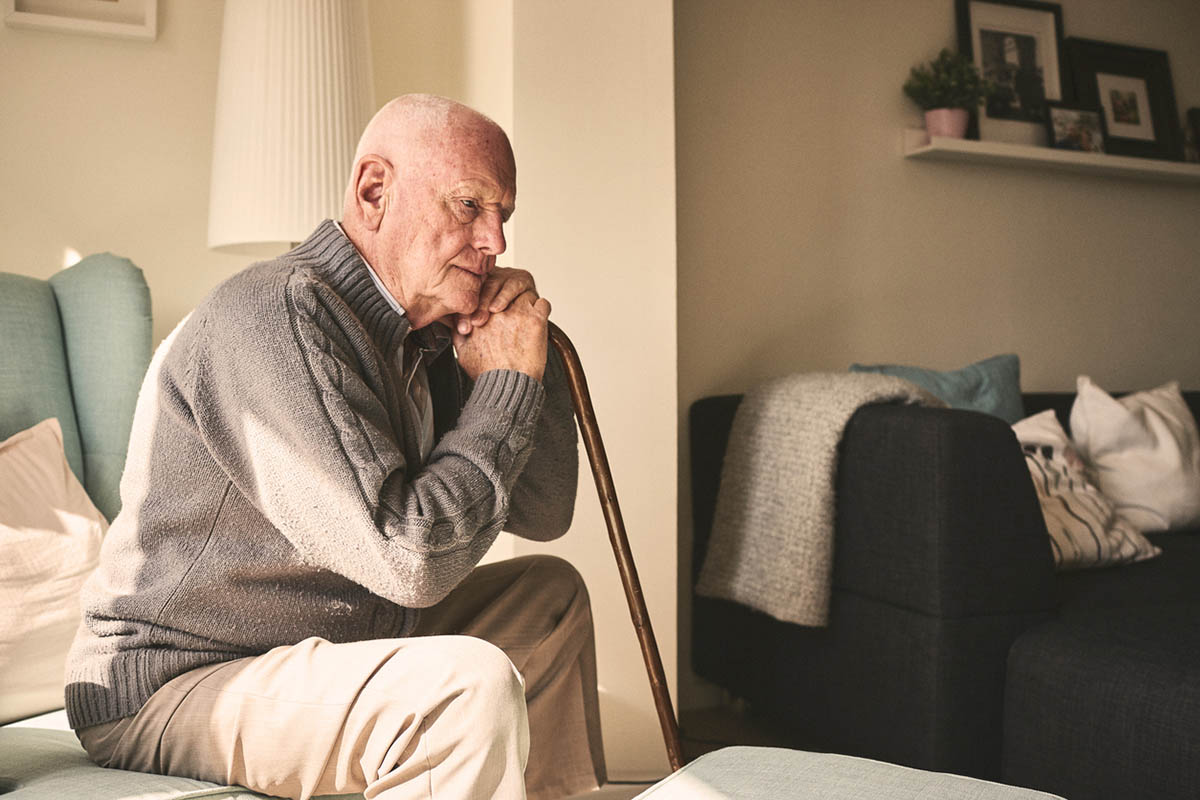Treatment-Resistant Depression Requiring Electroconvulsive Therapy Following Stem Cell Transplantation
To the Editor: In an effort to improve hematologic cancer outcomes, there is growing interest in combining psychiatric and oncologic treatment. We present the first report of a patient with depression resistant to multiple antidepressants who underwent serial electroconvulsive therapy (ECT) sessions following allogeneic stem cell transplantation (SCT).
Case report. Ms A is a 38-year-old woman with acute T-cell lymphoblastic leukemia. Her past medical history is significant for hypothyroidism and depression with past trials of sertraline, bupropion, and escitalopram. Due to adverse effects, she has not taken antidepressants in 10 years.
Following diagnosis of leukemia, Ms A began chemotherapy and was started on mirtazapine, trazodone, and clonazepam treatment for mood symptoms. Her medical condition failed to improve and SCT was recommended. Additionally, psychiatry was consulted to evaluate for depression characterized by hypersomnia and anorexia without feelings of hopelessness and suicidal ideation. She screened negative for major depression and bipolar disorder. A psychiatric diagnosis was not made at this time.
Following SCT, Ms A’s symptoms worsened, so we prescribed venlafaxine and stopped mirtazapine therapy. Moreover, clostridium difficile colitis with hypothyroidism secondary to levothyroxine malabsorption contributed to her depression. Levothyroxine was given intravenously, and methylphenidate was started but discontinued due to anorexia.
Ms A’s SCT recovery was complicated by worsening mood, decreased nutritional intake, renal failure, respiratory failure, pericardial effusion, and physical deconditioning. These factors made rehabilitation difficult due to poor motivation and inability to maintain hygiene and complete tasks of daily living.
We increased Ms A’s venlafaxine and trazodone dosages. Despite these changes, due to her profound depression and refusal to eat, she was transferred to our inpatient psychiatric unit. We scheduled triweekly ECT for a total of 12 initial treatments. Ms A’s apathy worsened to the point of soiling herself and not informing her nurses, so we started her on olanzapine but stopped due to adverse effects. Concurrently, she continued ECT with appreciable improvements after 6 treatments.
After multiple weeks of ECT, Ms A’s Beck Depression Inventory score went from 29 to 12.1 Her mood and function markedly improved. Currently, she has no evidence of cancer relapse or graft rejection and returns to our hospital system for follow-up and bimonthly ECT maintenance.
There is growing interest in the relation between cancer and comorbid psychosocial distress, as well as psychiatric interventions optimizing clinical outcomes.2,3 True depression is reported in 4%-49% of cancer patients depending on the severity of the disease.4,5
Levels of depression and social support prior to SCT predict the extent of physical and emotional recovery.6 This is the first report of successful ECT following SCT, suggesting that ECT is safe and effective in patients with depression undergoing SCT.
Early neuropsychiatric intervention in cancer patients leads to better patient outcomes and long-term reductions in psychosocial distress, but surveys suggest that physicians rarely manage depression until late in the disease course.7 One reason may be a desire to minimize cost. Another possibility is the lack of a standardized approach to cancer patients with mood disorders. These reasons may explain why ECT is so underutilized. Given the rapid response demonstrated with ECT, early treatment may be more cost effective by preventing prolonged hospitalization. Further cost analysis is warranted to compare ECT versus less invasive treatment and longer hospital stay.8-13
For our patient, ECT correlated with improved Beck Depression Inventory scores and daily functioning consistent with the literature.14 Her gradual worsening of depression and medical complications may have delayed ECT. Earlier treatment may have decreased hospitalization time and improved overall recovery.
Further investigation into the efficacy of ECT in patients with multiple comorbidities following SCT is warranted. Earlier improvement of depressive symptoms may prevent medical complications and shorten recovery time. Future cost analysis would be helpful to compare early ECT with minimally invasive treatment.
References
1. Beck AT, Ward CH, Mendelson M, et al. An inventory for measuring depression. Arch Gen Psychiatry. 1961;4(6):561-571. PubMed doi:10.1001/archpsyc.1961.01710120031004
2. National Comprehensive Cancer Network. NCCN practice guidelines for the management of psychosocial distress. Oncology (Williston Park). 1999;13(5A):113-147. PubMed
3. Galway K, Black A, Cantwell M, et al. Psychosocial interventions to improve quality of life and emotional wellbeing for recently diagnosed cancer patients. Cochrane Database Syst Rev. 2012;11:CD007064. PubMed doi:10.1002/14651858.CD007064.pub2
4. Pirl WF. Evidence report on the occurrence, assessment, and treatment of depression in cancer patients. J Natl Cancer Inst Monogr. 2004;32(32):32-39. PubMed doi:10.1093/jncimonographs/lgh026
5. Walker J, Hansen C, Martin P, et al. Prevalence of depression in adults with cancer: a systematic review. Ann Oncol. 2013;24(4):895-900. PubMed
6. Syrjala KL, Langer SL, Abrams JR, et al. Recovery and long-term function after hematopoietic cell transplantation for leukemia or lymphoma. JAMA. 2004;291(19):2335-2343. PubMed doi:10.1001/jama.291.19.2335
7. Jacobsen PB, Ransom S. Implementation of NCCN distress management guidelines by member institutions. J Natl Compr Canc Netw. 2007;5(1):99-103. PubMed
8. Husain MM, Rush AJ, Fink M, et al. Speed of response and remission in major depressive disorder with acute electroconvulsive therapy (ECT): a Consortium for Research in ECT (CORE) report. J Clin Psychiatry. 2004;65(4):485-491. PubMed doi:10.4088/JCP.v65n0406
9. Prieto JM, Blanch J, Atala J, et al. Psychiatric morbidity and impact on hospital length of stay among hematologic cancer patients receiving stem-cell transplantation. J Clin Oncol. 2002;20(7):1907-1917. PubMed doi:10.1200/JCO.2002.07.101
10. Kellner CH, Knapp RG, Petrides G, et al. Continuation electroconvulsive therapy vs pharmacotherapy for relapse prevention in major depression: a multisite study from the Consortium for Research in Electroconvulsive Therapy (CORE). Arch Gen Psychiatry. 2006;63(12):1337-1344. PubMed doi:10.1001/archpsyc.63.12.1337
11. Kalapatapu R. Electroconvulsive therapy. Medscape. http://emedicine.medscape.com/article/1525957-overview#a01. Updated June 26, 2012. Accessed March 26, 2014.
12. Kellner CH, Greenberg RM, Murrough JW, et al. ECT in treatment-resistant depression. Am J Psychiatry. 2012;169(12):1238-1244. PubMed doi:10.1176/appi.ajp.2012.12050648
13. Gelenberg A, Freeman M, Markowitz J, et al. Practice Guideline for the Treatment of Patients With Major Depressive Disorder. 3rd ed. Washington, DC: American Psychiatric Association; 2010:44.
14. The UK ECT Review Group. Efficacy and safety of electroconvulsive therapy in depressive disorders: a systematic review and meta-analysis. Lancet. 2003;361:799-808.
Author affiliations: College of Medicine, University of Nebraska, Omaha.
Potential conflicts of interest: None reported.
Funding/support: None reported.
Published online: August 28, 2014.
Prim Care Companion CNS Disord 2014;16(4):doi:10:4088/PCC.14l01640
© Copyright 2014 Physicians Postgraduate Press, Inc.





